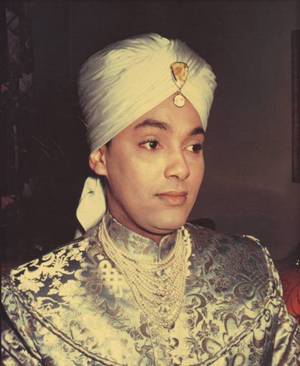
Korla Pandit
By Andrew Hamlin
Northwest Asian Weekly
Two hands hold a large censer. A voice speaks of wisdom and rubies. A deep, slightly scraggly voice. The action fades-in to a man in a turban with a jewel mounted between his eyes. Fixing his eyes upon the camera, Korla Pandit begins his act.
And his act was the Hammond Organ, augmented with a Steinway piano to his right. Playing mostly organ, occasionally piano, sometimes one with each hand, Pandit played for fifteen minutes on Los Angeles’ KTLA-TV from 1949 until 1951. He did not rock and roll and he did not get down and dirty with the blues, but he flitted easily between all other types of music, playing popular tunes, show tunes, traditional, and ethnic music from around the world. He was one of the first television stars, but he never spoke on camera. The narrator off-screen was someone else.
And Korla Pandit had reason to never speak. Speaking might have given away his secret.
John Turner’s film “Korla” covers the organist’s life from start to finish, but not in that order. He starts with the censer, the myth, the exotica (for Korla Pandit was a pioneer of “exotica”) and goes considerably into Pandit’s keyboard skills combined with his elegance and mystery, his easy way of wining over an audience. Pandit’s work grew popular with folks who ironically were into tiki torches and vintage cocktails, folks who wanted to overlook rock and roll or step into a time machine and come out back before rock and roll first rolled.
But Pandit’s work, cheesy as it could get, transcended kitsch. He knew how to play to the camera and reach his audience through the camera, with his galvanizing eyes bolstered with the glinting jewel, the white of the turban combined with the milk chocolate of his skin. He hammered down Hammond keys with the heel of his hand, his palms, and even his forearms. He took chestnuts such as “Over The Rainbow” and gave them fresh illumination with rapid runs, melancholy swells, double-time breaks, and piano intermezzos.
Pandit never admitted to anyone that he was not actually Indian—not from India or elsewhere. He was not from the Far East or the Near East. He was born John Roland Redd, in St. Louis in 1921.
The “exotic” persona came partially from his wife, a white lady Beryl June DeBeeson, and partially from a film the future Pandit’s sister appeared in—a film featuring a black man disguised as an Indian. With a turban and a jewel.
And the fascinating, damnable thing was that passing for Indian worked wonders for him. He was no longer a black man, but he was one of the first black men to have his own TV show. His birth certificate lists him as “colored”; his death certificate asserts he was “white.” His family appears to have gone along with his fake background, although his wife and older son have since died, and his younger son, for whatever reason, does not appear in the film.
He exploited the exotic background story for his own ends and to that extent must be deemed selfish. But not solely selfish. Many black people who could, passed for white. And as Pandit/Redd demonstrated, passing as anything was preferable to being black.
He preached the universal language of music. He was a fraud, but he was a spiritual optimist. And as Carlos Santana remarks, he opened vortexes. Anything seemed possible when he pressed the keys. Any dimension, any identity. Any form. Any triumph. (end)
For more information “Korla,” visit /www.korlapandit.com.
Andrew Hamlin can be reached at info@nwasianweekly.com.




The idea of the Turban in the Head of the so-called African-American, is to inform the People of the Earth that the Wearer is not a “Negro, colored folk, black people, though He fabricated His original, He was correct as to His Heritage, as the So-called African-Americans are from the Ancient Holy Lands called today India, Persia, etc…
The Moorish-Americans were hard at work in the 1920ies, in Chicago, St.Louis, Detroit, Indiana, Philadelphia etc… And many used the Moorish Ancient Attire to transform out of the Slave clothing known as Blackman.